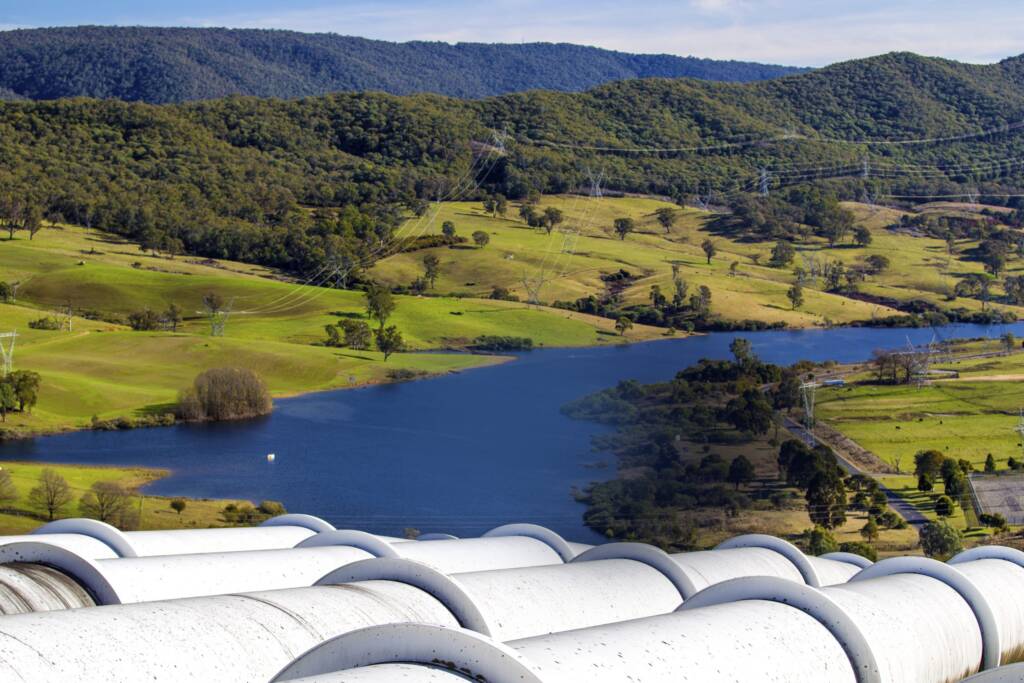The Snowy Mountains Scheme, one of Australia’s most iconic infrastructure projects, has been a cornerstone of the country’s renewable energy strategy for decades. With the Snowy Hydro 2.0 expansion now underway, the project aims to increase energy storage and hydroelectric capacity. However, as with many large-scale engineering projects, it has encountered several hurdles. Here’s an overview of the progress, construction challenges, and delays affecting the Snowy Hydro Power Station.

Scenic view of pipelines winding through the green hills and valleys of the Snowy Mountains region, illustrating the integration of energy infrastructure with natural landscapes.
Progress and Overview
The Snowy Hydro 2.0 project is designed to add 2,000 MW of energy storage capacity, positioning it as a key player in Australia’s transition to renewable energy. This expansion involves the construction of 27 kilometers of tunnels between two existing reservoirs, along with the installation of state-of-the-art turbines. Progress has been steady, with tunneling operations well underway. However, the sheer complexity of the project and the challenging terrain of the Snowy Mountains have led to significant delays in the overall timeline.
Construction Challenges
One of the primary causes of delays has been the geological challenges encountered during tunneling. The mountains’ hard rock formations have proven more difficult to navigate than initially anticipated, leading to slower-than-expected progress. Tunneling through these tough geologies has required advanced drilling equipment and techniques, adding to the overall project costs and timeline. Furthermore, water inflows during the excavation process have posed additional engineering challenges, requiring complex solutions to avoid damage to the tunnels.

A cross-sectional diagram showing the layout of the Snowy Hydro 2.0 project, including the underground power station, inclined pressure shaft, and tunnels connecting the Tantangara and Talbingo reservoirs. This diagram illustrates the complex engineering challenges posed by the project.
Delays and Setbacks
Construction issues have also arisen due to the remote location of the project. Accessing the Snowy Mountains site and delivering the necessary materials has proven logistically challenging. The harsh environmental conditions, particularly during winter months, have also caused setbacks, making it difficult for construction crews to operate efficiently. These factors have collectively delayed the project’s timeline, pushing back the expected completion date.
Design Issues and Integration
Design issues have further compounded the delays. Integrating new infrastructure with existing dams and reservoirs, which were built decades ago, has required meticulous planning and adjustments. The aging infrastructure has presented compatibility challenges with modern technology, forcing designers to adapt and re-engineer certain aspects of the project. This has been a critical step in ensuring that the new components, such as the turbines and underground pumping stations, operate seamlessly with the existing hydroelectric system.

A map of Australia’s major renewable energy infrastructure projects, with Snowy Hydro prominently marked, showing the geographical context of the Snowy Hydro 2.0 project.
Timeline and Future Prospects
Originally slated for completion by 2026, the Snowy Hydro 2.0 project is now expected to face significant delays, with some estimates suggesting the timeline could extend into the early 2030s. Despite these setbacks, the project remains a vital part of Australia’s renewable energy future. Once operational, it will play a critical role in stabilizing the national grid by providing energy storage that supports intermittent renewable sources like wind and solar.
Final Thoughts
The Snowy Hydro Power Station, despite its delays and challenges, remains a symbol of Australia’s commitment to sustainable energy. As the project moves forward, overcoming both construction and design hurdles, it will ultimately contribute to a cleaner and more resilient energy infrastructure for the country.


